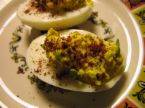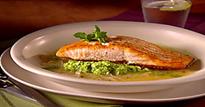
|
Salmon Facts, and a Recipe!
by Patty Liston
 We love salmon. Light in texture, mild in taste, easy to cook and oh-so-good for you, this fish is a favorite in our homes. However, unless you are fortunate enough to live near a great fish market, most of the salmon we see is in a package. Unless we know what to look for, this delicious fish can be a little underwhelming. So, here are some great tips for you.
Four Signs of Freshness
1. The flesh should be firm and moist, with shiny skin and no dry patches.
2. The fish should smell clean, not fishy or ammonia-like.
3. The fish should be protected from direct contact with ice. If it's sitting in a pool of melted ice at the shop, it was probably frozen or is freezer burned, and you shouldn't buy it.
4. If buying a whole salmon, look for clear, not clouded, eyes, firm flesh and red gills.
Storage
It's best to cook on the day of purchase, but salmon keeps better than most fish and will hold up for a day or two.
To refrigerate, wrap salmon in plastic wrap and then put it in a plastic bag. Set a colander over a bowl, fill the colander with ice, and wedge the bagged salmon into the ice.
To freeze, wrap salmon tightly in several layers of plastic wrap, then place in a freezer bag and into the freezer. Salmon should be good for up to two months. Defrost in the refrigerator before cooking.
Nutrition
All salmon, whether wild or farm-raised, is an excellent source of protein and B-vitamins. It's the omega-3 fatty acids, though, that make it an excellent addition to any diet. Omega-3s are essential fatty acids, a substance our bodies cannot manufacture and must get from food. Researchers are constantly finding new health-giving properties in these amazing fats. Some of the health benefits are:
Lowers triglycerides and cholesterol and reduces inflammation
Protective against some cancers
Reduces symptoms of rheumatoid arthritis
Helps relieve depression and stress
Lowers blood pressure in some people with hypertension
Helps fight wrinkles
If you eat canned salmon, you also get the benefits of calcium in the small bones that are ground up in the flesh during processing.
Wild salmon usually has more Omega-3 fats than farm-raised. Wild also has the distinct advantage of fewer PCB's, industrial pollutants showing up in farm-raised salmon.
Salmon Dill Eggs
Emeril Lagasse
 1 dozen hard-boiled large eggs, peeled 1 dozen hard-boiled large eggs, peeled
1/4 cup mayonnaise
1/4 cup sour cream
2 ounces smoked salmon, finely chopped
2 teaspoons chopped fresh dill, plus more for garnish
1 teaspoon fresh lemon juice
1 teaspoon freshly ground black pepper
1/2 teaspoon salt
Slice the eggs in half lengthwise and carefully remove the yolks. Press the yolks through a fine-mesh sieve into a mixing bowl. Add the mayonnaise, sour cream, salmon, dill, lemon juice, pepper, and salt. Stir to blend. Spoon the mixture into the egg whites. Cover and chill for at least 1 hour before serving. Sprinkle with chopped dill before serving.
 Download this recipe.
Salmon in Lemon Brodetto
By Giada DeLaurentis Download this recipe.
Salmon in Lemon Brodetto
By Giada DeLaurentis
 Lemon Brodetto:
tablespoons olive oil
1 shallot, diced
2 lemons, juiced
1 lemon, zested
2 cups chicken broth
1 tablespoon chopped fresh mint leaves
Pea Puree:
2 cups frozen peas, thawed (about 10 ounces)
1/4 cup fresh mint leaves
1 clove garlic
1/2 teaspoon kosher salt
1/2 teaspoon freshly ground black pepper
1/2 cup extra-virgin olive oil
1/2 cup grated Parmesan
Salmon:
1/4 cup olive oil
4 (4 to 6-ounce) pieces salmon
Kosher salt
Freshly ground black pepper
To make the Lemon Brodetto, warm the olive oil in a medium saucepan over medium heat. Add the shallots and saute until tender, about 7 minutes. Add the lemon juice, zest, and broth. Bring to a simmer, and keep warm, covered, over low heat.
To make the Pea Puree, combine the peas, mint, garlic, salt, and pepper in a food processor and puree. With the machine running, add the olive oil in a steady drizzle. Transfer the pea puree to a small bowl and stir in the Parmesan. Set aside.
To make the Salmon, warm the olive oil in a large, heavy skillet over high heat. Season the salmon pieces with salt and pepper. Sear the salmon until a golden crust forms, about 4 to 5 minutes on the first side. Flip the fish and continue cooking until medium-rare, about 2 minutes more depending on the thickness of the fish.
To assemble the dish, add the tablespoon chopped mint to the Lemon Brodetto and divide between 4 shallow dishes. Place a large spoonful of Pea Puree into the center of each bowl. Place a salmon piece atop each mound of Pea Puree. Serve immediately.
Contribute to the Cook'n Club!
DVO would love to publish your article, prose, photography and art as well as your cooking, kitchen and nutrition tips, tricks and secrets. Visit the Newsletter Submission / Win Win for All section in our Forum for more information and details.
|
|



